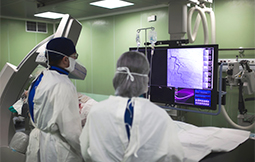
Angiography is a kind of X-ray used to check blood vessels. Blood vessels do not display clearly on a normal X-ray, so a special dye requires to be injected into your blood first.
Angiography is a kind of X-ray used to check blood vessels. Blood vessels do not display clearly on a normal X-ray, so a special dye requires to be injected into your blood first. This highlights your blood vessels, enabling your doctor to see any problems. The X-ray images produced during angiography are called angiograms.
Your doctor may recommend that you should have Angiography if you have:
Before your angiogram method starts, your health care team will examine your medical history, including allergies and medications you take. The team may do a physical exam and check your vital signs — blood pressure and pulse. You’ll also empty your bladder and switch into a hospital gown. You may have to remove contact lenses, eyeglasses, and hairpins.
Angiography is performed in a hospital X-ray or radiology department.
For the test:
You lie on an X-ray table and a small cut (incision) is made over 1 of your arteries, usually near your groin or wrist – a local anaesthetic is used to numb the part where the cut is made
A very thin flexible tube (catheter) is injected into the artery
The catheter is carefully guided to the area that’s being examined (such as the heart)
A set of X-rays are taken as the dye flows through your blood vessels
The test can take between 30 minutes and 2 hours. You’ll usually be able to go home a few hours afterward.
You will be monitored for 4 to 6 hours. You will be provided with a written form of instructions. Please follow these at home. A radiologist will evaluate you before you are discharged. Then your physician will discuss the test results with you. If you have diabetes, do NOT take Glucophage (metformin hydrochloride) for 48 hours after the test to decrease the risk of kidney complications.
For a few days or weeks afterward, it’s common to have:
A very small lump or collection of blood near where the cut was made
There’s also a very small risk of more serious complications, such as an allergic reaction to the dye, a stroke or a heart attack.
Copyright © 2021 IMA | All Rights Reserved.